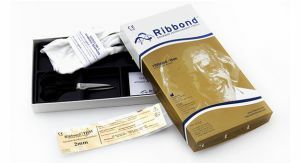 Ribbond is a tape that is fixed to the teeth with adhesive properties. The use of tires is a method of preventing the destruction of composite materials and dental plastics. The use of the material is indicated for splinting teeth in various clinical situations.
Ribbond is a tape that is fixed to the teeth with adhesive properties. The use of tires is a method of preventing the destruction of composite materials and dental plastics. The use of the material is indicated for splinting teeth in various clinical situations.
Due to the special weaving of the tape, which consists of strong fibers and high compatibility with any adhesive systems, the results are preserved for a long time.
- content
- material properties
- material properties
- application method
- application method
- orthodontic retouching application
- superimposition of the tire Overlapping of the denture
- Bridging
- Using as a pin
- Special instructions
- Material price
Variety of bands and bundling of
sets TiresRibbond consist of a special kind of fiberglass. They are available in 3 types:
- Standard tape .Produced in a box of blue color and has a thickness of 0.35 mm. The marking of the kit will be blue.
- Tape with complex weaving THM .It has a thickness of 0.18 mm and has a greater elasticity than the standard one. In this case, the kit will go in a box of golden color.
- Thinner ribbon Ultra .Its thickness is only 0.12 mm. Of all the presented variants, this one is best adapted in the oral cavity. The box will be silver.
The following kit kits are available:
- Starter kit .It includes 3 ribbons having a length of 22 cm. The width can be different: 2, 3 or 4 mm. A variant of their
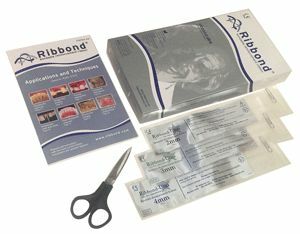 replacement is possible if necessary. Also, the set includes ribbons with a complex weave of 7 mm and 1 mm. A narrower one is used for fixing orthodontic retention. Also included are special scissors. They are necessary, since conventional can not cut glass fiber. Another important component is a soft foil. It is used for preliminary estimation of the required tape size. In the kit there will be an instruction for the use of the material.
replacement is possible if necessary. Also, the set includes ribbons with a complex weave of 7 mm and 1 mm. A narrower one is used for fixing orthodontic retention. Also included are special scissors. They are necessary, since conventional can not cut glass fiber. Another important component is a soft foil. It is used for preliminary estimation of the required tape size. In the kit there will be an instruction for the use of the material. - Set for further replenishment of .It also includes 3 ribbons having a length of 22 cm with different widths. Or you can replace it with one 68 cm tape of a certain size. The instruction is supplied with each set, as it is updated periodically. The set will also contain foil.
Material properties
The ribbon has special properties that distinguish it from other materials of this group:
- Special fiber structure .Thanks to a special patented weaving by the method of cross shuttle stitch, Ribbon easily fits and does not break integration in different directions. In addition, the bonding of the fiber inside the composite material is completely eliminated. Other similar tapes, the filaments in which go in one direction, quickly lose their structure. As a result, the tire under the influence of the load, cracks appear, which will not be when using Ribbond.
- No memorization of the form. This property ensures a dense and accurate application of the material. In the process of splinting teeth with periodontal disease, this property manifests itself in the form of a laminate effect. The material lies as close as possible to the surface of the
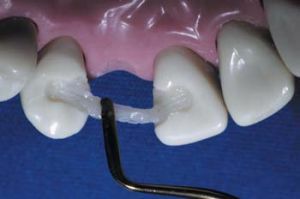 enamel, which ensures a high strength of the structure. When tapes are used as the basis of bridges, the fibers are laid in several layers, which also significantly increases the long-term work.
enamel, which ensures a high strength of the structure. When tapes are used as the basis of bridges, the fibers are laid in several layers, which also significantly increases the long-term work. - Compatibility with oral tissues .In this property, Ribbon's difference from ordinary fiberglass is apparent. The open ends of the fibers do not present any danger to the patient.
- Long shelf life .Due to the absence of restrictions on the time of use, the kits can be stored for a long time. Also the material does not require the use of a refrigerator.
When using
The sewing tape has a wide range of applications. It is used in the following clinical situations:
- overlapping of the suturing structure for periodontal diseases associated with increased mobility of the teeth;
- use as a basis for prosthetics after endodontic treatment;
- creation of a bridge, including one visit;
- tooth restoration with split syndrome;
- reinforcement of composite material;
- application as a retina after treatment with an orthodontist;
- stabilization of the teeth after traumatic injuries.
How to use
The instructions for use will depend on the clinical situation. It is worth examining those options that are most often used in practice.
Overlay of orthodontic retarder
They are manufactured directly in the oral cavity:
- cleansing of the tooth surface;
- creation of additional grooves, this stage is used only if necessary;
- enamel etching and use of an adhesive;
- application of a small layer of composite, special attention is paid to the contact between the teeth;
- application of an adhesive to Ribbons and its application to a composite;
- removal of excess composite and exposure of the first layer;
- application of an additional composite layer for greater strength of the retaner and lightening it;
- polishing.
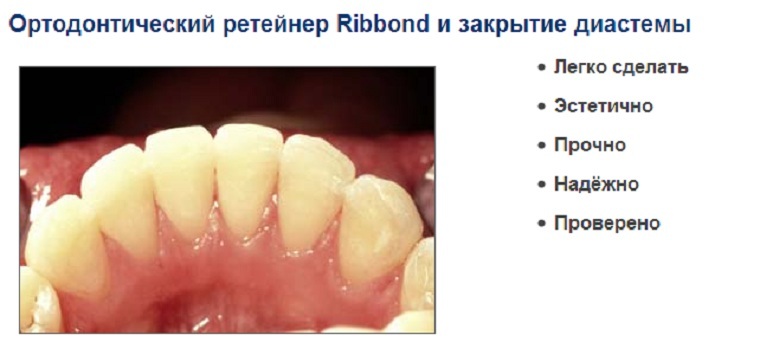
Overlay of the tire for periodontal disease
The procedure of application is as follows:
- Cleansing of the teeth to which the tire will be applied.
- Create special grooves for maximum aesthetics. If it was decided not to conduct tooth preparation, then it is recommended to make small depressions on the latter. This will help protect the tire ends from gradual stripping.
- Measure the length of the dentition with a foil from the set.
- Isolation of the operating field.
- Etching and applying adhesive to teeth.
- Insertion of the first composite layer.
- Adhesive tape processing.
- Fitting the tire onto the teeth.
- Additional adaptation in the area of the contact between the teeth. To avoid pulling out parts that have already been applied, it is necessary to hold them with your finger or tool.
- Removing excess composite and lighting.
- Polishing of the received structure.
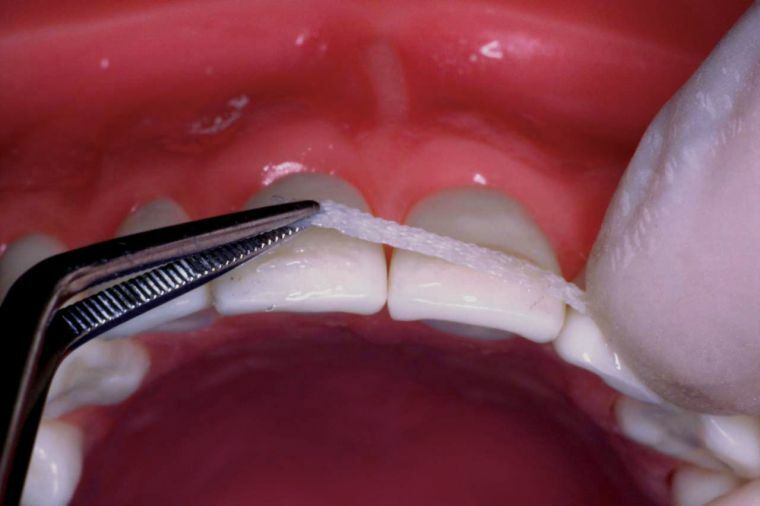
Manufacture of a bridge
Application technology Ribbon in this case:
- preparation of teeth according to the above procedure;
- application of the first layer of composite material;
- tape preparation using the bond;
- installing it on the teeth;
- removal of excess material and polymerization by light;
- processing by the bond of an additional tape that will strengthen the structure;
- polymerization;
- closing of the edges of the tape with a composite;
- creation of an intermediate tooth, most often it is modeled from a composite;
- check for bite and polishing the structure.
Use as a pin
The procedure is as follows: 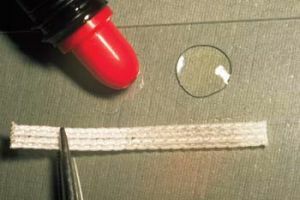
- preprocessing the root canal;
- etching of the channel walls and treatment with an adhesive;
- processing of the selected type of tape;
- insertion into the channel of special composite cement;
- insertion of the tape, its end should be visible above the crown;
- installation of the second tape and photopolymerization of the structure;
- restoration of the crown part.
Special instructions
The following types of materials are better for installing Ribbond. It is recommended to use an unfilled adhesive to impregnate the fiber. Self-etching systems should be abandoned.
As a basis, a composite with a weak filling is used;
For the finishing coat, a flowable composite is used.
The price of the material
The cost depends on the type of kit. Standard set with 22 cm ribbons will cost about 7300 rubles. Scissors are included in it.
The same set without scissors will cost 5,700 rubles. The cost of additional tapes is 2700 rubles.
Kits with longer ribbons cost slightly more. One such kit may cost 13,000 rubles.
